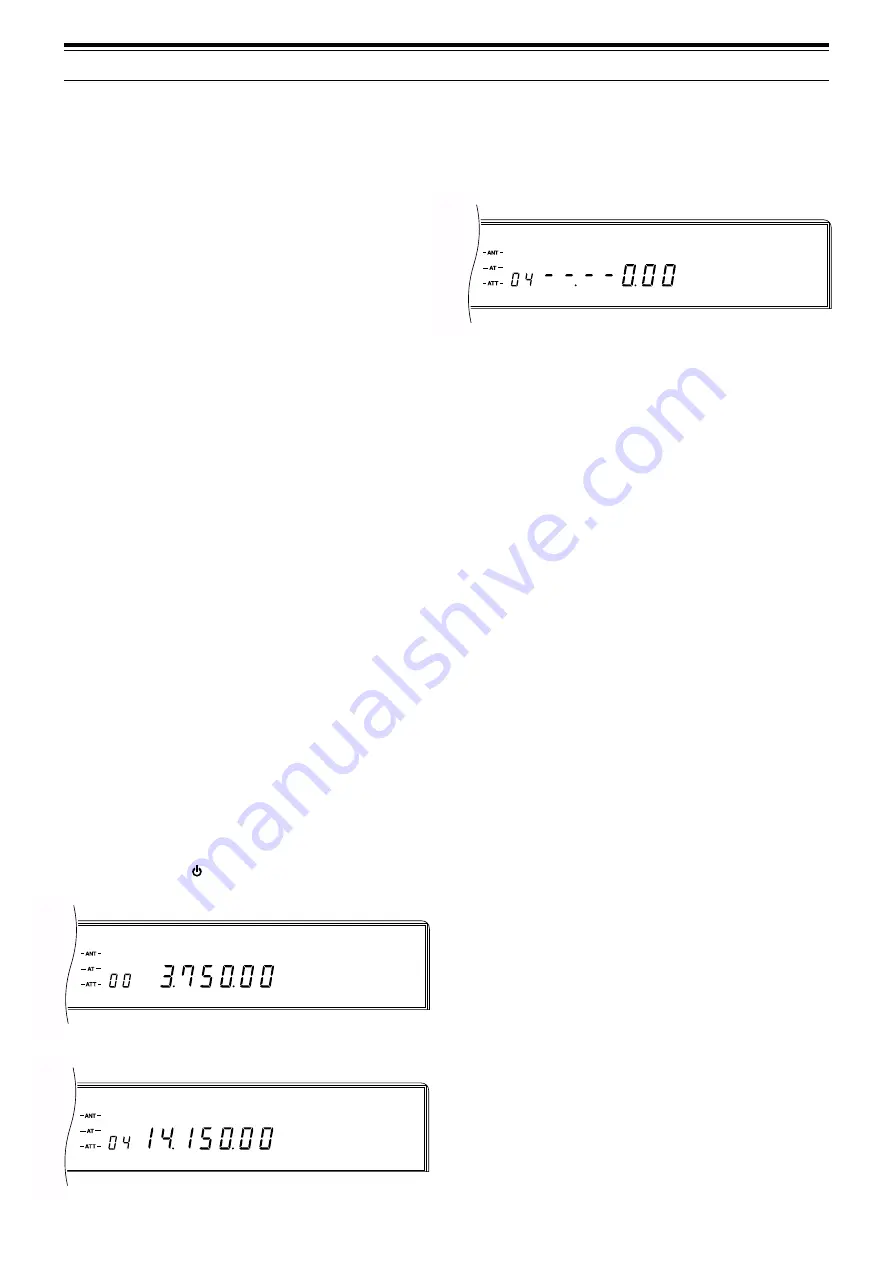
48
USB
AUTO
CW
AUTO
CW
AUTO
7 OPERATING AIDS
3
Press
[ENTER]
, then enter the frequency via the
keypad. Alternatively, you can enter the frequencies
by using the
Tuning
control or Mic
[UP]/[DWN]
.
Pressing
[UP]
or
[DOWN]
on the Front Panel
changes the frequency in 1 MHz steps.
•
“– –.– – 0.00” appears if
[ENTER]
is pressed.
•
The 10 kHz digit is the least significant that can
be entered therefore boundaries must be
multiples of 10 kHz.
•
Four digits must be entered. However, if
[ENTER]
is pressed after beginning to enter
digits, 0 is entered automatically for the remaining
un-entered digits, and frequency entry is
completed.
•
If you enter a wrong digit, press
[CLEAR], [ENTER]
then re-enter the entire
frequency.
4
Press
[LSB/USB]
or
[CW/–R]
or
[FSK/–R]
or
[FM/AM]
to select the mode for this boundary.
5
Repeat Steps 2 ~ 4 for each boundary that you want
to change.
6
Press
[CLR]
to exit from this mode.
•
Switching the power OFF before pressing
[CLR]
results in loss of the entered data.
USING AUTOMATIC MODE
Toggle Automatic Mode ON or OFF via Menu No. 34
(AUT.MODE). The default is OFF. When Automatic
Mode is ON, you can always change the mode
manually by pressing a Front Panel MODE button. An
Automatic Mode boundary must be crossed for the
mode to automatically change.
Automatic Mode does not work if you change bands by
pressing
[UP]
or
[DOWN]
. Instead, the mode last used
on the newly selected band will be recalled from the
band memory. Switching ON the 1MHz Step function
will allow Automatic Mode to work when using
[UP]
or
[DOWN]
.
In SSB mode when Automatic Mode is OFF, the
transceiver automatically selects LSB for frequencies
lower than 9.5 MHz, and selects USB for 9.5 MHz or
higher frequencies if the
Tuning
control or Mic
[UP]/[DWN]
is used to cross the frequency of 9.5 MHz.
This is also true if using the Front Panel
[UP]
or
[DOWN]
button. In all modes, the RIT or XIT frequency
shift is not taken into account by Automatic Mode. Also,
Automatic Mode will not function if a frequency is
entered via the keypad on the Front Panel.
AUTOMATIC MODE
Automatic Mode automatically selects the operating
mode according to a set of frequency and mode data
that you input. The purpose of Automatic Mode is for
the transceiver to select the correct mode for you as you
tune within a band. For Automatic Mode to work, you
must first program the frequency/mode relationships
that you want.
AUTOMATIC MODE BOUNDARIES
•
The defaults for all boundaries are 30 MHz USB.
•
Boundaries may only be changed (not deleted).
•
The mode assigned to a boundary will be selected
while operating on all frequencies below that
boundary down to and including the next lower
boundary.
•
Each boundary is numbered. As the boundary
numbers get larger, so must the boundary
frequencies.
Example:
If Boundary No. 09 is 14.100 MHz, then
Boundary No. 10 must be a frequency larger by at
least 10 kHz than 14.100 MHz. The lowest
frequency that could be stored in Boundary No. 10 is
14.110 MHz. A lower frequency will not be accepted.
•
Frequencies larger than the maximum receive
frequency cannot be stored.
•
There is a maximum of 19 boundary frequencies.
•
Automatic Mode is always “OFF” in the range from
the highest boundary to the maximum transceiver
frequency.
Example:
If 18 MHz CW is stored in Boundary
No. 14, tuning to 18 MHz or higher selects USB
since the boundary default of 30 MHz USB is stored
in Boundary No. 15. Whereas, if 18 MHz CW is
stored in Boundary No. 18 (highest boundary),
tuning to a frequency lower than 18 MHz selects CW
but tuning to 18 MHz or higher will not change the
mode (still CW).
Use the following procedure to change a boundary.
1
Press
[MENU]+[ ]
.
•
Boundary No. 00 appears.
2
Turn the
M.CH/VFO.CH
control to select the
boundary that you want to change.
Содержание TS-870S
Страница 104: ......
















































